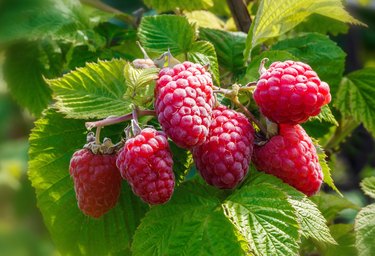
Perfect for eating fresh, freezing or making preserves, raspberries (Rubeus ideaus) are some of the easiest fruit shrubs to grow in a home garden. They come in red, yellow and black, with red varieties being the sweetest and most popular. Raspberries are fairly hardy – they can survive winters in U.S. Department of Agriculture plant hardiness zones 3 to 9 – which makes them an ideal fruit for Northern gardens. When a raspberry plant produces its first crop depends on the variety.
Primocanes vs. Floricanes
Video of the Day
Raspberries are considered perennial plants because their roots can survive for many years. Red raspberry plants can live between 10 and 15 years, while black raspberries have a shorter life span. The stems, or canes, of raspberry plants, on the other hand, are biennial, which means they only live for two seasons.
Video of the Day
In their first year, new canes are referred to as primocanes, while second-year canes are known as floricanes. Some varieties of raspberry can only produce fruit on floricanes. Other types can produce fruit on both primocanes and floricanes. This distinction determines when a particular type of raspberry yields a crop.
Types of Raspberry Fruit Shrubs
Most raspberries produce fruit on only floricanes, with the first crop coming a year after planting. These cultivars are known as summer-bearing raspberries. They generally produce fruit in June and July. Some red and yellow raspberries and almost all black varieties fall into this category. The popular 'Killarney' and 'Nova' raspberries are just two examples of summer-bearing raspberry varieties.
Other raspberry plants produce fruits on the tips of primocanes, even in the first year of planting, as well as on floricanes. The result is two crops a year, with the first coming on floricanes in June and July and the second on primocanes starting in late summer through the first frost of autumn. These raspberries are known as everbearing raspberries. Examples include the 'Heritage' raspberry, which bears large, sweet fruits that are perfect for eating fresh or for freezing. The fall crop tends to be more copious.
Caring for Raspberry Plants
Raspberries need full sun – six hours a day or more – in order to produce fruit, and they rely on bees for pollination. Raspberries also need lots of water during the growing season. Provide raspberries with 1 or 1.5 inches of water a week while the fruit is developing. The ideal soil pH for raspberries is between 5.6 and 6.2.
Keep the soil around your raspberry plants free of weeds to prevent unwanted vegetation from competing with your fruit shrubs for nutrients. On the other hand, onions, garlic, leeks and nasturtiums make good raspberry companion plants because they help to keep away pests.
Whether they are summer-bearing or ever-bearing, all raspberries must be trained on a trellis or another type of support. Raspberries must be pruned annually. Floricanes die after producing fruit, so remove them from the plant to keep diseases at bay. Thin out any diseased or weak primocanes, leaving behind only the strongest and most vigorous stems.
- University of Minnesota Extension: Growing Raspberries in the Home Garden
- Oregon State University: Growing Raspberries in Your Home Garden
- Arbor Day Foundation: Heritage Everbearing Raspberry
- Better Homes & Gardens: How to Grow Raspberries for the Juiciest Fruit You'll Taste This Summer
- University of New Hampshire Extension: Growing Fruits: Raspberries and Other Bramble Crops
- HGTV: Can I Plant Blueberries and Raspberries Together?
- Learn2Grow; Giving Your Garden Some Fruity Flavor; Megan Bame
- National Gardening Association: USDA Hardiness Zone Finder